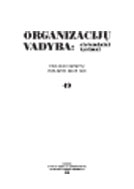Lietuvos pensijų sistemos reformos vertinimas: nuo koncepcijos iki pirmųjų anuitetų
RESEARCH OF LITHUANIAN PENSION SYSTEM’S REFORM: FROM CONCEPTION TO FIRST ANNUITIES
Author(s): Tadas GudaitisSubject(s): Economy
Published by: Vytauto Didžiojo Universitetas
Keywords: pensijų sistemos reforma; pensijų fondai; socialinio draudimo sistema; pension system reform; pension funds; social security system
Summary/Abstract: The beginning of pension system’s reform was determined by unavoidable social and economical conditions. The decreased number of birth rate, expanded emigration rate stimulated little number of employees (unemployment) and socially insured persons. The pension system reform was inevitable for solving feasible related problems in the future. Firstly, it was of utmost importance to change the financing source for the existing pension system. The most important reasons of pension reform in Lithuania were described in the White book in 2000 (Baltoji pensijų reformos knyga, 2000). The necessity to change the pension reform in the way that retired people would get higher pension compared to the existed one was a long-term goal described in the conception of the pension reform. Moreover, the aim was that at the same time the redistribution of social incomes should not increase, but rather decrease. The main condition of the pension reform, started in 2003, was secure that pensioners would receive their pension from the two sources - the social security budget and private pension funds. These two sources would gradually safeguard the growth of their pension. At the same time the government would ensure stable pension financing. Lithuanian pension system reform is based on pillared fix-income voluntary premium accumulation in Pillar 2 Pension Funds. The successful beginning of the reform showed that optimistic predictions exceeded. The data of July 1st, 2008 show that the number of participants grew by one third and 955.6 thousand participants who signed contracts for Pillar 2 Pension Funds. It was 30 percent higher than planed. Therefore, the pension accumulation system developed faster than planned and settled a higher premium sum from the Social Security Fund to the Pillar 2 Pension Funds. Analysis on investment return showed, that the Pillar 2 Pension Funds investment returns corresponding to investment returns of the main world indexes. In order to make a more detailed analysis of the Pillar 2 Pension Funds investment results, there is a need that some years of investment performance should pass. Moreover, in order to make a relevant analysis of long-term and short-term investment return results of at least 5-7 years are needed. On the top of that, investment risk indicators should be evaluated.
Journal: Organizacijų vadyba: sisteminiai tyrimai
- Issue Year: 2009
- Issue No: 49
- Page Range: 37-56
- Page Count: 20
- Language: Lithuanian

